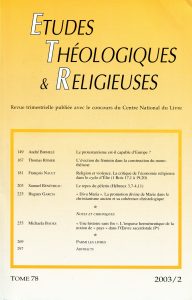Hugues Garcia prolonge ici sa réflexion commencée dans une précédente livraison (ETR 2002/2, p. 193-216) sur le statut de Marie dans le discours oecuménique contemporain. Il essaie de construire, à partir de livres récents, la trajectoire promotionnelle du personnage de Marie dans le christianisme ancien et d’en dégager une cohérence christologique. L’enquête passe en revue différents contextes comme divers corpus de textes, notamment les sources hérésiologiques et la littérature apocryphe. Paul l’apôtre est également invoqué et interprété comme un vecteur majeur et paradoxal de la promotion remarquable de la mère de Jésus. Le propos s’achève sur la nécessité de reconnaître différentes cohérences christologiques à l’oeuvre dans le discours sur Marie et de refuser, au nom même de ces cohérences, toute tentative « syncrétiste » de la réduire ad unum. La liberté du croyant de passer de l’une à l’autre, selon ses besoins ou selon l’évolution de son imaginaire, est à ce prix.
This article follows up a study initiated in a previous article (ETR 2000/2, p. 193-216) about the status of Mary in the contemporary ecumenical discourse. Relying upon recent works, it strives at mapping out the promotion campaign of the character of Mary in ancient Christianity and aims at unveiling a christological consistency. The investigation surveys various contexts, as well as various textual corpora, particularly the heresy sources the apocryphal writings. The Apostle Paul is referred to and regarded as a major and paradoxical conveyor of the outstanding promotion of the mother of Christ. The argument closes on the necessity to distinguish different christological consistencies at work in the discourse on Mary and to refuse, on the basis of these consistencies, any attempt at syncretism that would reduce her ad unum. This is the condition to ensure the freedom of the believer to shift from one to the other, according to his needs or to the evolution of his imaginary representations.
p. 225-253
Auteur
GARCIA Hugues
Hugues GARCIA est pasteur à l'église réformée du canton des Grisons en Suisse.
